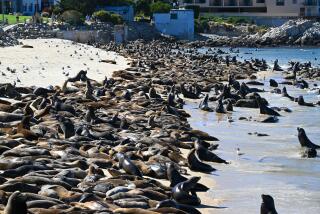Outings : SHORELINES : Egg Roles : At McGrath State Beach in Oxnard, fenced-in families of endangered least terns snuggle into shallow holes in the sand.
- Share via
Sixteen-year-olds Sandy Bauerle and her friend, Martha Mekeel, set up camp at McGrath State Beach. Had this been the weekend, chances are good that they would have been surrounded by the 100 or more tents that typically are pitched on the same grassy area.
As it was, it was an overcast Monday, and the teen-agers felt as if they had the place to themselves.
In truth, they had more company than they knew.
Less than 300 yards away, in a fenced-off two-acre area, a small number of least terns snuggled into shallow holes in the sand.
“Least terns?” Martha asked. “Does that have something to do with earthquakes?”
Actually, it has more to do with survival.
Least terns are small, delicate birds that have joined other vanishing wildlife on the endangered species list.
With their curved, graceful wings, they resemble swallows, but their flight pattern quickly sets them apart.
Fluttering in midair with their wings beating wildly, the birds suddenly compress their bodies and divebomb into the water, hunting fish for their young.
“They are so delicate compared to other shore birds,” Park Ranger A.W. Zilke said. “They’re just beautiful to watch.”
The species has diminished in large part because of the rapid disappearance of wetlands, the natural habitat for the terns.
According to Zilke, about 90% of the wetlands in the state have been destroyed by development.
In Ventura County, Zilke said, there are only two known areas where the birds--whose overall population is estimated at only a few thousand--now nest. One is at McGrath State Beach in Oxnard, where three separate nesting sites have been identified and fenced-off to the public. The other nesting area is at Point Mugu.
Although least terns are drawn to wetland areas, they make their nests in open areas along the beach.
To cushion and warm the eggs, females pluck feathers from their own chest area and place them in shallow holes in the sand. Eleven pairs of nesting birds have been identified at McGrath.
“The problem is that their nests are open and exposed in the sand, and so there is a very high mortality rate from humans, dogs, vehicles and other birds that eat the eggs,” Zilke said.
Last year, only six baby birds are known to have survived.
To alert the public to the struggling species, park rangers or naturalists now conduct daily nature walks from McGrath beach’s camping area.
Groups of 20 to 30 people are led along a narrow trail that leads to the estuary. On the way, they get a condensed lesson on edible and poisonous plants in the area, as well as plants that were used by Indians for various purposes.
“I had 11 kids on a walk this morning,” Zilke said. “They’re very interested in all of this. And of course, they want to know the names of everything.”
Once visitors reach the end of the trail and the sandy beach begins, the panorama of wetlands stretches out in front of them. Hundreds of pelicans are gathered in the distance, and sea gulls swoop down near the shore, an occasional scream piercing the silence.
In addition to the nature walks, a newly erected sign describes the plight of the birds and the need to keep a respectful distance from the fence.
Twelve-year-old Jeff Berman, who was planning to sleep under the stars with a large group of children from Camp Ramah in Ojai, said he had read about the least tern and was sad about it.
“I hate it that they’ve built all this stuff and destroyed the environment,” he said. “I care that the bird is endangered.”
Until more people feel the same way, rangers say, the terns’ continued existence will be tenuous.
Just a few days ago, Zilke said, he was walking from the camping area to the estuary when he heard loud explosions punctuating the nighttime quiet.
There, right next to the fenced nesting area of the birds, was a group of boys who were exploding bottle rockets into the air.
“They were a bunch of Boy Scouts,” Zilke said, shaking his head. “They had no idea where they were.”
More to Read
Sign up for Essential California
The most important California stories and recommendations in your inbox every morning.
You may occasionally receive promotional content from the Los Angeles Times.










